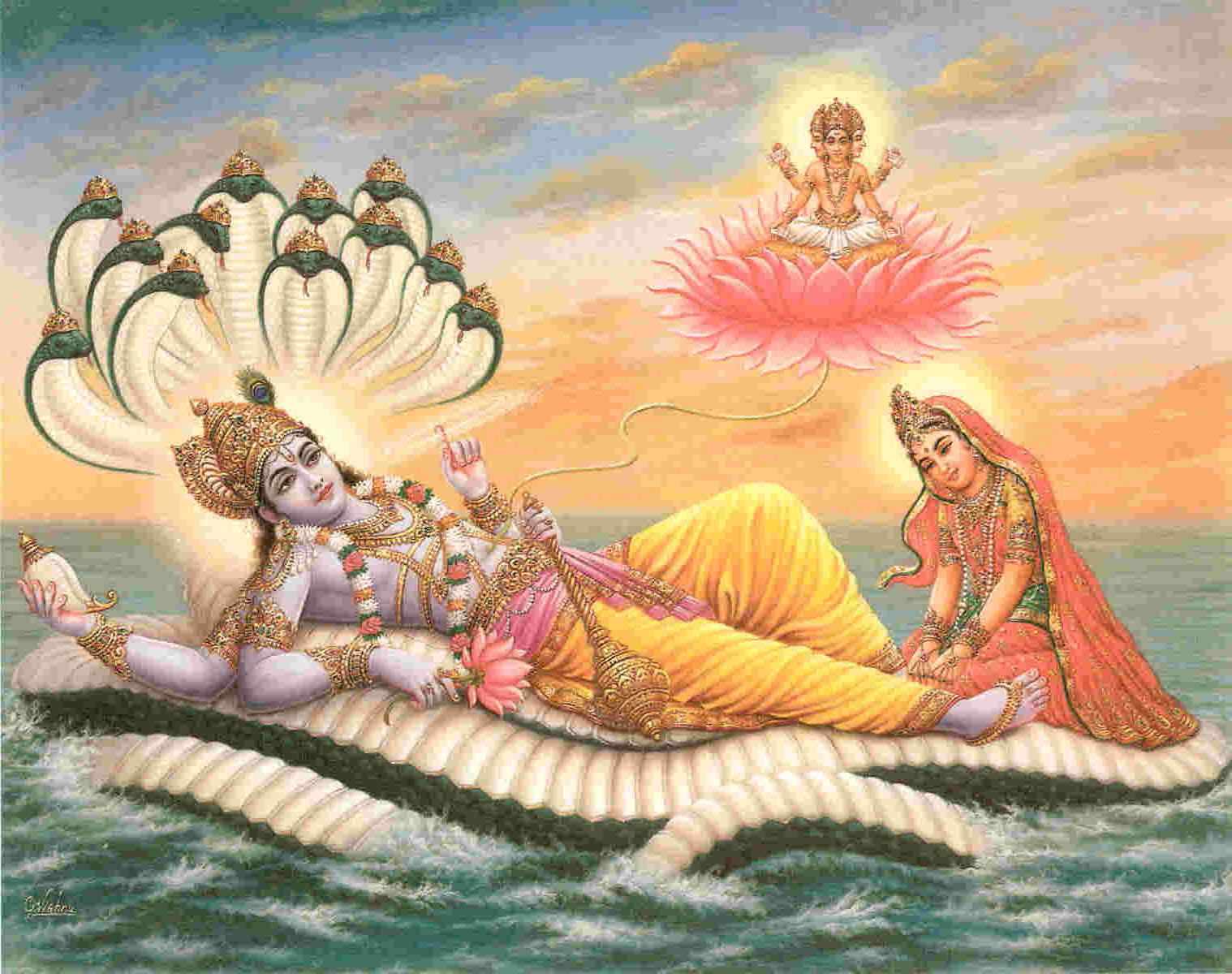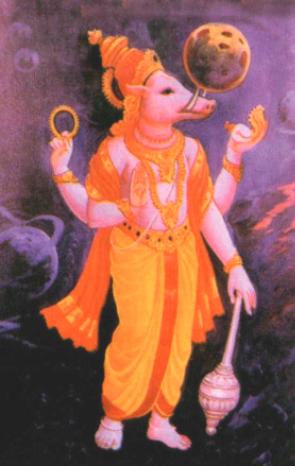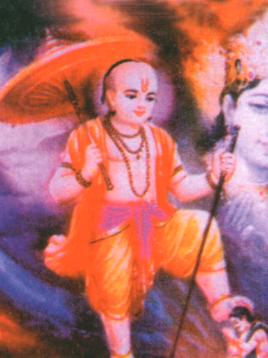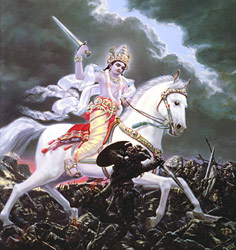Many ancient indian puranas mention the adventures of Emperor Rama born in Ikshavaku Dynasty who ruled the Empire of Khosala and had vanquished the mighty and cruel Ravana. His capital city was Ayodhya. His rule was benevolent and prosperous. He was famous for his dharmic conduct. Srimad Ramayana authored by Maharshi Valmiki is the biography of Rama. It is considered the first proper literary work of human civilization. This work deals exclusively and extensively with the life of Rama. It is certain that the events described in the work were real incidents. Of course, to accept Rama as an incarnate of God or an excellent human ruler is our individual discretion.
Millions of Hindus, across the world, believe Sri Rama to be an avatar of Sri Maha Vishnu. Lord had declared in Bhagavad Gita,"
yada yada hi dharmasya
glanir bhavati bharata
abhyutthanam adharmasya
tadatmanam srujamya aham
i.e.
Whenever and wherever there is a decline in Dharmic practice, O descendant of Bharata, and a predominant rise of Adharma--at that time I descend Myself."
Dharma means the righteous practices laid out by the holy scriptures(Shaastras). Adharma is the behaviour that has been barred by the scriptures(Shaastras). People who live according to the edicts of Dharma are considered as Sajjana(Good guys). People who violate Dharma are considered as Adharmics. They are called as Durjjana(bad guys).
It is believed that Sri Maha Vishnu takes avatars whenever the Dharma is being undermined by Adharma and when Sajjanas(virtuous people) are being harrassed by Durjjanas(bad guys). Regardless of the avatar, the primary objective of every avatar is to reinstall the Dharma by defeating the Adharmics.
Sri Maha Vishnu's usual abode is called Vaikuntam. It is the world of Lord Vishnu. In this world, he is accompanied by his consort, Goddess Lakshmi. Lord Vishnu has lotus-petal like dark beautiful eyes. He has four hands, in which, he holds a Conch, a Disc, a Mace and a lotus. He is also armed with a sword that hangs at his hip. He is dark coloured resembling a dark cloud saturated with humidity. Lord Vishnu, is usually, depicted as lying on a couch formed by a serpant. This serpant is a devotee of Lord and his name is Adi Shesha. The name of the Conch is Panchajanya, the name of Disc is Sudharshana, Mace is known as Gomodhakee, Sword i called Nandaki.
Goddess Lakshmi is the eternal companion of Lord Vishnu. Goddess Lakshmi is the presiding deity of wealth and prosperity. Lakshmi is the shakti of Vishnu. It means that Lord Vishnu's power/energy is Goddess Lakshmi. Goddess Lakshmi is serving at the holy feet of her Lord. Out of love for her, Lord Vishnu offered his heart as a suitable place for Goddess Lakshmi. But Goddess Lakshmi chose the holy feet of Lord Vishnu as her abode, out of love for him. Thus, they are cosmic couple made for each other.

Lord Vishnu is one of the Trinity of Super-Gods. The three Super-Gods are Lord Brahma, Lord Vishnu and Lord Shiva. Lord Brahma is the creator of Universe. Lord Vishnu is the sustainer of the Universe. And Lord Shiva is the dissolver of the Universe at the appropriate time. After the dissolution of the Universe, a new creation begins. The cycle of Creation-and-Dissolution is an endless and beginingless cycle that runs eternally.
Lord Brahma has four heads. His consort is Goddess Saraswati. She is the presiding deity of all knowledge and arts. Lord Brahma creates the Universe through the Vedic chanting and Tapa. Tapa means meditative penance. Prolonged periods of tapa give rise to increase in spiritual energy of the performer. Lord Brahma was born from a lotus that originated from the navel of Lord Vishnu. Hence, Lord Vishnu is considered a father of Lord Brahma. In the above picture, Lord Brahma can be seen sitting in the lotus that has its root in the navel of Lord Vishnu. Three heads of Lord Brahma can be seen in the picture. The fourth head is behind and hence is not depicted in the picture.
Since Lord Vishnu is the sustainer of the Universe, he is tasked with taking out bad guys. Lord Vishnu has taken innumerable Avatars and Semi-Avatars to achieve this purpose. What is an Avatar? An Avatar is an incarnation of Lord himself. What is a Semi-Avatar? A Semi-Avatar is a partial incarnation of Lord. Lord bestows some of his divine powers on a very righteous person to protect Dharma. Once, the objective is achieved, the divine powers are withdrawn from that person like anybody else. This phenomenon is called Semi-Avatar. Parashurama is a Semi-Avatar. An Avatar on the other hand is completely divine. When the Lord himself descends to protect Dharma, it is called as Avatar.
Lord Vishnu has a vehicle. This vehicle is a divine bird. His name is Garuda.
In the picture below, Lord Vishnu can be seen along with Goddess Lakshmi seated on Garuda.

Sri Maha Vishnu is said to have taken many many avatars and several semi-avatars to cleanse the world of wicked people and wrong practises. Out of these, some of the major and popular Avatars are enumerated below.
Some of the major avatars are:
1. Matsya, the fish, first appeared in the Krita Yuga(see following picture).

In this avatar, the Lord restored the Vedas from the demon Hayagreeva.
2. Kurma, the tortoise, first appeared in the Krita Yuga(see following picture):
 In this avatar, the Lord helped the Great Ocean Churning(Samudra Mantana). The Great Milk Ocean held Amrita, an elixir that frees one from death and aging. To obtain that Amrita, the Milk Ocean had to be churned. Devas(Gods) and Asuras(Demons) got together and churned the Milk Ocean with the blessings of Lord Vishnu.
In this avatar, the Lord helped the Great Ocean Churning(Samudra Mantana). The Great Milk Ocean held Amrita, an elixir that frees one from death and aging. To obtain that Amrita, the Milk Ocean had to be churned. Devas(Gods) and Asuras(Demons) got together and churned the Milk Ocean with the blessings of Lord Vishnu.3. Varaha, the boar, first appeared in the Krita Yuga(see following picture).
 In this avatar, the Lord eliminated Hiranyaksha. Hiranya-aksha was the brother of Hiranaya-kashyap. Hiranya-aksha was harassing the mother earth, so he was slain by Lord in this avatar.
In this avatar, the Lord eliminated Hiranyaksha. Hiranya-aksha was the brother of Hiranaya-kashyap. Hiranya-aksha was harassing the mother earth, so he was slain by Lord in this avatar.4. Narasimha, the half man/half lion first appeared in the Krita Yuga.
 In this avatar, Lord saved a great devotee of his named Prahaladha. Hiranya-kashyap was torturing his own son Prahaladha because he was Lord's devotee. To punish Hiranya-kashyap and to protect Prahaladha, Lord incarnated as Narasimha.
In this avatar, Lord saved a great devotee of his named Prahaladha. Hiranya-kashyap was torturing his own son Prahaladha because he was Lord's devotee. To punish Hiranya-kashyap and to protect Prahaladha, Lord incarnated as Narasimha.5. Vamana, the dwarf, first appeared in the Treta Yuga.(see following picture)
 Prahaladha obtained a boon from Lord. The boon was that Lord would not kill anyone of his race, no matter what they do. After that, several years later, Prahaladha's grandson Bali defeated Indra. Indra sought help from the Lord. So, the Lord incarnated as the Vamana and deceived Bali into giving his entire empire as a donation. After that, Bali went away to netherland. Lord promised him that he would become the next Indra.
Prahaladha obtained a boon from Lord. The boon was that Lord would not kill anyone of his race, no matter what they do. After that, several years later, Prahaladha's grandson Bali defeated Indra. Indra sought help from the Lord. So, the Lord incarnated as the Vamana and deceived Bali into giving his entire empire as a donation. After that, Bali went away to netherland. Lord promised him that he would become the next Indra.6. Parashurama, Rama with the axe, first appeared in the Treta Yuga.(see following picture)
 This is a semi-avatar. Parashurama punished the misrulers of his era by slaying them. After the advent of Rama avatar, Parashurama's divinity was reclaimed by Rama. Later, Parashurama became a disciple of Dattatreya and gained the true knowledge and became emanicipated by achieving Moksha.
This is a semi-avatar. Parashurama punished the misrulers of his era by slaying them. After the advent of Rama avatar, Parashurama's divinity was reclaimed by Rama. Later, Parashurama became a disciple of Dattatreya and gained the true knowledge and became emanicipated by achieving Moksha.7. Rama, Ramachandra, the human Emperor of Khosala, first appeared in the Treta Yuga.(see following picture)
 Lord was born as a humble human prince. He eliminated innumerable demons, the chief of them being Ravana. These demons were harassing all the righteous people and causing much harm to Dharma. Lord punished all of them and re-installed the dharmic rule. He spent 11000 years on the earth living the life of a dharmic human being to establish an ideal for all the human race.
Lord was born as a humble human prince. He eliminated innumerable demons, the chief of them being Ravana. These demons were harassing all the righteous people and causing much harm to Dharma. Lord punished all of them and re-installed the dharmic rule. He spent 11000 years on the earth living the life of a dharmic human being to establish an ideal for all the human race.8. Sri Krishna: A complete avatar. First appeared in Dwapara Yuga. He is revered as Jagadguru(teacher of the world) for giving Bhagadwad Gita.(see following picture)
 Lord manifested in this avatar to cleanse the world from the Adharmic. The rakshas were born as Kshatriyas(warriors). So, the Lord guided Arjuna and thereby eliminated all the Adharmics.
Lord manifested in this avatar to cleanse the world from the Adharmic. The rakshas were born as Kshatriyas(warriors). So, the Lord guided Arjuna and thereby eliminated all the Adharmics.9. Some consider Buddha to be the ninth avatar of Sri Maha Vishnu. While, some others consider Balarama to be ninth avatar of Sri Maha Vishnu:
The Sri Vaishnavas, a sect of hindus who worship Vishnu, do not believe that Buddha was Vishnu's incarnation, but another sect of hindus, Madhvas believe that Buddha was indeed Vishnu's incarnation. There is mention of Buddha in Brahmanda Purana as an avatar of Vishnu whose objective is to delude the Asuras(demons) by preaching a false religion so that their account of good karma(punyam) be decreased. Whether the Buddha being mentioned in the purana is same as Gautama Buddha, the originator of Buddhism, is unclear.
Buddha(see following picture):

Balarama is the elder brother of Sri Krishna and is said to be incarnation of Shesha(the serpant devotee of Sri Maha Vishnu)
Balarama(see following picture):

Sesha(serpant in the following picture), Lord Vishnu is resting on Sesha(serpant) while Goddess Lakshmi(Goddess of wealth and well-being) is serving her lord. Lord Brahma is seated on a lotus which has originated from the navel of Lord Vishnu. Therefore, Lord Vishnu is also called Padmanabha(lotus-navel):

10. Kalki(see following picture): an avatar that is yet to manifest. This avatar is supposed to come in Kali Yuga(we presently live in Kali Yuga). Once the injustices(adharma) reach the zenith then Sri Maha Vishnu will take an avatar of Kalki to cleanse the earth of of bad guys and protect the good guys. He will also establish Dharma by conquering Adharma.

The Indian ancient Time Divisions:
----------------------------------------------------------------------------------------------------------------------------------------------------------------------------
If you are confused with the words Yuga, heres some explanation. According to ancient indian science, the time is divided into four yugas. In modern age, we divide time into AD and BC. This division is based on the supposed birth and death of Jesus of Nazareth, the central figure in Christianity. BC refers to 'Before Christ' while AD refers to 'Anno Domini'. There is another division also that we use in modern times, Ancient period, medieval period and modern period. Similarly, the ancient indians divided time into four yugas:
First Yuga is Krita(or Satya) Yuga: This is the first Epoch or Yuga. In this Yuga, righteousness is predominant while the unrighteouness is under check. All the beings were saturated with energy, radiance and strength. Dharma was duly followed by most people. Rakshas(demons) lived on the earth. Devas(Gods) could be seen by the naked eye of mortals. People living in this Epoch/Yuga had great punya(good karma). Any slight misconduct would be immediate be punished by the Devas(Gods). Dharma is generally symbolised by Ox/Bull. It is said that, in Krita Yuga/Epoch, Dharma(symbolised by Bull) used to walk on all the four legs. Lord Vishnu resides in the heart of every mortal. He wore white garment in Krita Yuga. White symbolises peace and purity. White also stands for Sattva Guna. The general life expectancy was much much longer in Krita Yuga. People could live for One Lakh Years. Water, air, and food were pure and unpolluted. This Yuga is considered Golden Yuga.
Krita Yuga is made up of 1728,000 Years. Each Epoch or Yuga can be divided 3 parts. The first part is Sandhi period or Conjuction Period. The second period is the Actual Period. The third period is again Sandhi period or Conjuction Period. Sandhi Period or Conjuction Period is a period of time when the effects of two Yugas can be seen. That is one Yuga is ending while another is going to start or one Yuga has ended while another is has started. During this time, the signs of two Yugas can be seen this called as Sandhi Period. Then, there is Actual Period. During this period, the effects of only that Yuga can be seen. Every Yuga has two Sandhi Periods and an Actual Period. The Sandhi Periods are much shorter than the Actual Period. Every Actual Period is preceded and succeded by a Sandhi Period.
Krita Yuga has 1728,000 Years.
Krita Yuga can be divided into 3 periods:
Sandhi Period= 144000 Years
Actual Period= 1440000 Years
Sandhi Period= 144000 Years
-------------------------------
Total Yuga = 1728000 Years.
-------------------------------
Second Yuga is Tretha Yuga: In this Yuga/Epoch, Dharma was slightly undermined. Resultantly, Adharma increased slightly. Dharma(symbolised by Ox) used to walk on only three legs. Lord Vishnu, residing in the hearts of mortals, wore a red garment. Red stands for Rajo Guna. The general steadfastness towards Dharma decreased and consequently, the spiritual energy of people diminished. But the people still could witness the Devas(Gods) with their physical eye. Rakshas(demons) still lived on the Earth. The general life-expectancy was reduced greatly, but still people could live for tens of thousands of Years. The immunity of the people reduced and new diseases started, but they could be checked. This Yuga is considered Silver Yuga.
Treta Yuga has 1296,000 Years.
Treta Yuga can be divided into 3 periods:
Sandhi Period= 108000 Years
Actual Period= 1080000 Years
Sandhi Period= 108000 Years
-------------------------------
Total Yuga = 1296000 Years.
-------------------------------
Third Yuga is Dwapara Yuga: In this Epoch/Yuga, Dharma was greatly diminished. Now, Dharma and Adharma were in equal proportion. The people lost much of their physical, mental and spiritual prowess. They were confused and found it hard to discriminate between right and wrong. Due to the loss of spiritual energy, people could no longer see Devas(Gods). People's intelligence, physical power and emotional balance were greatly reduced. Only few exceptional beings were still responsible for the Dharmic Conduct. Rakshas(Demons) relocated to the Patala or Netherworld. Patala or Netherworld is supposed to be under the oceans. Dharma(symbolised by Ox) walked only on two legs. Lord Vishnu wore a yellow garment in this Epoch/Yuga. Yellow is a mixture of Rajo Guna, Tamo Guna and Sattva guna. The life-expectancy of people was about one thousand years. The immunity of people was lost. And diseases made occassional presence. This Yuga is considered Bronze Yuga.
Dwapara Yuga has 864,000 Years.
Dwapara Yuga can be divided into 3 periods:
Sandhi Period= 72000 Years
Actual Period= 720000 Years
Sandhi Period= 72000 Years
-------------------------------
Total Yuga = 864000 Years.
-------------------------------
Fourth and final Yuga is Kali Yuga: In this Epoch/Yuga, Dharma was almost lost. Adharma had taken over. All mortals were under the sway of Kali and resorted to various sins with a relish. They lost all fear of Devas(Gods) and all shame from sins(Papam). They did not respect their elders nor care for the people lesser than themselves. The people were very weak, and all sorts of diseases were rampant. The people had lost all intelligence but still wallowed in pride and delusion. Fathers were humiliated by sons and husbands were humiliated by wives. Women were not cared for. The people of Kali, were weak-hearted and weak-willed. They did not adhere to any Dharma. They live only to enjoy sensual pleasures. Dharma(symbolised by a Bull) walked only one leg. Lord Vishnu, resided in mortal's heart, wearing a black garment. Black symbolises Tamo Guna. Rakshas entered into the hearts of human beings. Atheism and agnostism was on rise. The life-expectancy in this Epoch/Yuga was One Hundred Years. This Yuga is considered Iron Yuga.
Kali Yuga has 432,000 Years.
Treta Yuga can be divided into 3 periods:
Sandhi Period= 36000 Years
Actual Period= 360000 Years
Sandhi Period= 36000 Years
-------------------------------
Total Yuga = 432000 Years.
-------------------------------
Mahayuga:All the four Yugas are referred to together as one Mahayuga. A Mahayuga starts with Krita(or Satya) Yuga. Then, Treta Yuga follows. Then, Dwapara Yuga follows and finally Kali Yuga occurs. After the end of Kali Yuga, Mahayuga also ends.
1 Mahayuga = Satya Yuga + Treta Yuga + Dwapara Yuga + Kali Yuga.
=> 1 Mahayuga = 1728,000 years + 1296,000 years + 864,000 years + 432,000 years.
=> 1 Mahayuga = 4320,000 Years.
After the completion of every Mahayuga, another Mahayuga starts with a new Krita Yuga.
Manvantara: One Manavantara is made up of 71 Mahayugas.
1 Manvantara= 71 Mahayugas.
=> 1 Manvantara= 71* 4320,000 Years.
=> 1 Manvantara= 306,720,000 Years.
Every Manvantara has a new Manu and Indra. Thus, the life-time of an Indra is 306,720,000 Years.
Kalpa:14 Manavantaras equal 1 Kalpa. In addition, a Kalpa has an Adhi Sandhi period. This Adhi Sandhi Period is 1,728,000 years.
Thus,
1 Kalpa = 14 Manvantaras + 1,728,000 Years.
=> 1 Kalpa = 14 * 306,720,000 Years + 1,728,000 Years.
=> 1 Kalpa = 4,295,808,000 Years.
Lord Brahma's Life-time:
1 Kalpa forms one day-time of Lord Brahma. Then, there is an equivalent amount of night time when Lord Brahma rests. During this time, there is no creation. Thus, 1 Kalpa of Creation is followed by another Kalpa of dissolution. 2 Kalpas form one Day of Lord Brahma. 30 such Days form one month. 12 such months form one Year for Lord Brahma. Lord Brahms lives for 100 such years.
Thus,
1 Brahma's life time= 2 Kalpas(1 day) * 30(days of month) * 12(months of year) * 100(years).
=> 1 Brahma's life time = 2* 360 * 100 Kalpas.
=> 1 Brahmas' life time= 72,000 Kalpas.
After the end of this period, a new Brahma replaces the old one. The new Brahma originates from the Lotus born from Lord Vishnu's navel.
Reckoning of time amongst the pitrs (Dead Ancestors):
- 1 human fortnight (14 days) = 1 day of the pitrs
- 30 days of the pitrs = 1 month of the pitrs = (14 x 30 = 420 human days)
- 12 months of the pitrs = 1 year of the pitrs = (12 months of pitrs x 420 human days = 5040 human days)
- The lifespan of the pitrs is 100 years of the pitrs (= 36,000 pitr days = 504,000 human days)
Reckoning of time amongst the Devas(Gods).
- 1 human year = 1 day of the Devas.
- 30 days of the Devas = 1 month of the Devas. (= 30 human years)
- 12 months of the Devas = 1 year of the Devas = 1 divine year (= 360 human years)
- The lifespan of the Devas is 100 years of the Devas (= 36,000 human years)
----------------------------------------------------------------------------------------------------------------------------------------------------------------------------
Lord Rama is said to be the human incarnation of Lord Vishnu. He has lived his life like any normal human being. He had no extra-ordinary divine or occult powers. Yet, he lived every second of his life strictly in accordance with Dharma as prescribed by Shaastras(Vedas and those scriptures that have Vedas as their basis). Therefore, Rama's life is often declared as an ideal role model for all human beings. Rama is called Maryad Purushottam. Purshottam means the best among men and maryada would broadly mean respect. Maryada also means boundary. Here, Maryada means boundary of righteousness which bestows respect on those who do not cross it. Rama is called Maryada Purushottam because he commanded respect from all the righteous people by not crossing the boundary of Dharma.
Whether we take Rama as a great indian king who led a extraordinarily virtous life or take him as a god incarnate, is upto us. But there is little doubt that his life can teach us many valuable lessons. Not just moral or spiritual lessons but his biography gives us tips about the day-to-day social interactions, managing emotional relationships, insight into political ploys, financial dealings, business mangagement techniques, war strategies, self-development tools, and communication methods. It has a great contemporary use along with its spiritual, and religious side. Any human being who wants to be a adorable husband, a virtuous son, a loving elder brother, a good friend, or a fearsome rival has to atleast once read about the legendary life of Sri Rama. Ramayana is first and best book that teaches 'how to win over friends and defeat enemies'.
No comments:
Post a Comment